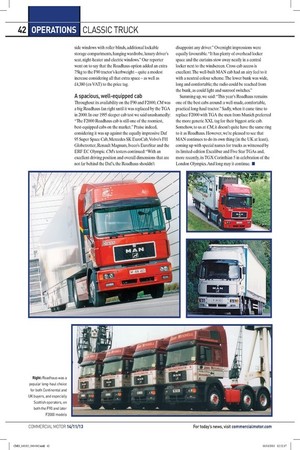avarian
Page 34

Page 35

If you've noticed an error in this article please click here to report it so we can fix it.
haus party
In a new series celebrating the first generation of big high-roof cabs that became a home for countless European long-haul drivers in the 80s and 90s, CM sings the praises of MAN's mighty Roadhaus By Brian Weatherley
IT'S FUNNY HOW a simple word or phrase can go in one ear, and rattle around your head for years afterwards. That's exactly how we feel about MAN's high-roof Roadhaus cab, originally offered as an option on the Bavarian manufacturer's classic F90 and F2000 models.
Somehow the Teutonic moniker sounds just right, suggesting a large and comfortable home on the road (which indeed it was). So it comes as a surprise to learn that the name didn't originate in Munich, but 794 miles to the west of Bavaria, in Swindon — the British home to MAN Truck & Bus. MAN's UK marketing team has a reputation for coming up with their own local model names. And when it came to providing one for MAN's first high-roof cab they plumped for Roadhaus. Short, snappy, memorable, and using the German spelling for house meant it kept the connection to the manufacturing pedigree too.
The big Bavarian cab first broke cover in 1989 at the massive IAA Truck Show in Germany as part of the F90 range. With a width of 2,440mm, length of 2,205mm and comfortable internal height of 2,170mm, the distinctive high-roof cabin was described by MAN as "an aerodynamically designed piece of art, with characteristic tinted side-windows integrated flush into the composite roof". All the latest 'gadgets' Still considered a classic today, the air-suspended Roadhaus came with all the usual little extras beloved of TIR travellers like air-con and electric-tilt and sliding-roof vent as well as a fridge, TV and video player (then the epitome of in-cab entertainment). By 1992 the F90 brochure was naturally bigging up MAN's exclusive high-roof (though other high-roofs were available, not least from Daf and Volvo) listing "the driver's optimum freedom of movement inside; large storage space above the windscreen; tinted side windows with blinds; and
comfortable indoor climate". Yet it would take another year before CMwas reporting that MAN was now offering a RHD version of its high-roof cab, albeit six months later than scheduled. "The glass-fibre top will be available on F90 372,422 and 502 [MAN's 500hp V10-powered big-banged tractive units. The twin-bunk Roadhaus cab offers 2.17m of standing headroom over the footwells. Headroom in the bunks is 0.89m in the lower bunk with 0.83m in the top. Features include double-glazed and tinted
side windows with roller blinds, additional lockable storage compartments, hanging wardrobe, luxury driver's seat, night-heater and electric windows." Our reporter went on to say that the Roadhaus option added an extra 75kg to the F90 tractor's kerbweight — quite a modest increase considering all that extra space — as well as £4,380 (ex-VAT) to the price tag. A spacious, well-equipped cab Throughout its availability on the F90 and F2000, CM was a big Roadhaus fan right until it was replaced by the TGA in 2000. In our 1995 sleeper cab test we said unashamedly: "The F2000 Roadhaus cab is still one of the roomiest, best-equipped cabs on the market." Praise indeed, considering it was up against the equally impressive Daf 95 Super Space Cab, Mercedes SK EuroCab, Volvo's FH Globetrotter, Renault Magnum, Iveco's EuroStar and the ERF EC Olympic. CMs testers continued: "With an excellent driving position and overall dimensions that are not far behind the Daf's, the Roadhaus shouldn't
disappoint any driver." Overnight impressions were equally favourable. "It has plenty of overhead locker space and the curtains stow away neatly in a central locker next to the windscreen. Cross cab access is excellent. The well-built MAN cab had an airy feel to it with a neutral colour scheme. The lower bunk was wide, long and comfortable; the radio could be reached from the bunk, as could light and sunroof switches." Summing up, we said: "This year's Roadhaus remains one of the best cabs around: a well-made, comfortable, practical long-haul tractor." Sadly, when it came time to replace F2000 with TGA the men from Munich preferred the more generic XXL tag for their biggest artic cab. Somehow, to us at CM, it doesn't quite have the same ring to it as Roadhaus. However, we're pleased to see that MAN continues to do its own thing (in the UK at least), coming up with special names for trucks as witnessed by its limited-edition Excalibur and Five Star TGAs and, more recently, its TGX Corinthian 5 in celebration of the London Olympics. And long may it continue. •








































